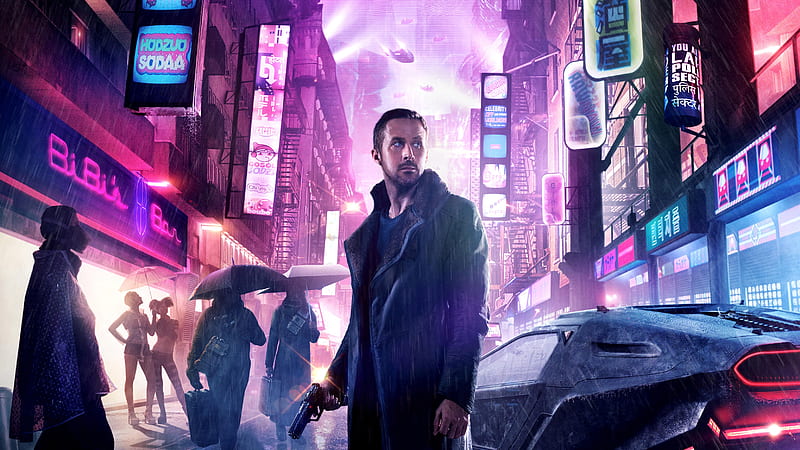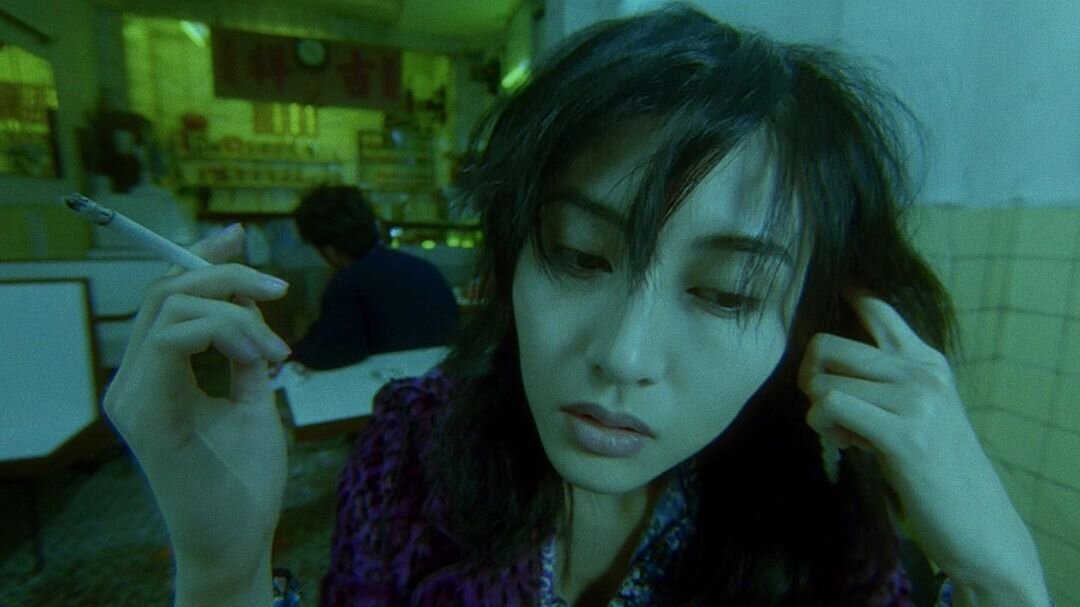Hong Kong
35 Analysis by Chloe Li
Chloe Li
Hong Kong and Techno-Orientalism
Overview
The East, or what the West refers to as the “Orient,” is an othering geopolitical, cultural, and social concept that has been constructed to maintain Western economic, cultural, and political hegemony over the East. This concept, known as “Orientalism” has branched off since industrialization into a new form, known as “Techno-orientalism” where the West embodies the East through hyper-technological lenses, promoting the idea that the East Asians are humanoid creatures living in a post-futuristic world. Not only does Techno-orientalism bring misrepresentation to the East socially, but the ideology also hypersexualizes East Asian media in a way that strips all meaning and history from the East. Thus, since Hong Kong cinema has had such an incredibly large impact on East Asian media, it is not surprising that Techno-orientalism has infiltrated the Hong Kong media scene and has commodified the aesthetics into shallow, and unrecognizable representations.
I. Introduction
Robots, cyborgs, flashing neon lights in a foggy city of hustling workers. To understand techno-orientalism, we must first discuss orientalism and the history it comes from. According to Edward Said (1979), who was one of the first people to coin the term “Orient” in context with the East and West, “Orientalism” is the theory and practice used by the West to dominate and control the East through projected perspectives of the East. By purposely misinterpreting the East via the media, the West bolsters its hegemony in political and economic forms to keep Eastern power at bay, whether or not the East actually presents a “threat.”
Diverging from that concept, “techno-orientalism” is thus the hyper-technological and futuristic portrayal of the Orient, most commonly depicted from East Asian influences. Techno-orientalism has permeated into many forms of media, but the same image of robots and cyborgs that greatly resemble East Asians with soft, non-Eurocentric features living in a dystopian city creates a general basis for which techno-orientalism operates: that East Asians are unfeeling, brainwashed, futuristic sub-humans in need of Western liberalization. This representation runs parallel to the basis of Orientalism, where Western (more specifically, White) saviorism maintains the idea of Western supremacy, justifying its interference in non-Western regions.
Much of this techno-orientalist discourse stems from the 1980s, during the boom of Japanese industry, especially in media and technology. Think anime, Sony, automobiles, and Nintendo, where their rising influence diffused into the Western economy at an almost alarming rate never seen before. As the West fears the rising East, they also attempt to mimic and “borrow” from that Eastern success without ever returning to the reality and authenticity of the East. Thus, by combining this fear-mongering and admiration, they reach a conclusive ideology of the techno-orientalist aesthetic that fetishizes the East whilst maintaining the hyper-technological success brought by the East because apparently, such success can only belong to the West—progress in science and technology is only acceptable in the hands of the West, else the result is an apocalyptic, un-human world that retains primitive and undeveloped culture, displacing the East from the present while simultaneously projecting the East as stuck in the worst outcome of the past and the future.

II. An extended analysis of techno-orientalism: A discussion about techno-orientalism and gender
Let us now discuss techno-orientalism and its relationship to gender. In general, the connection between the Patriarchy and Whiteness is already closely intertwined and can be summarized by the portrayal of power by Whiteness and men that systematically dominate non-Whiteness and non-masculinity. (Rich) White men thus hold authority and all diverging systems of oppression are created to serve white men and their desires. This comparison, however, also includes the dynamic between the West and the East, where the West presents itself as a dominating establishment and paints the East under the light of a weak, docile, and dependent region that absolutely implores the West for interference and help. As a result, the East is constantly compared to that of a woman. Unsurprisingly, people from the East (in this case, East Asian people) are characterized to be more feminine, regardless of their gender.
Otherizing has this effect of making the other party homogeneous and uniform. Techno-orientalism otherizes East Asia, unable to make a distinction between East Asians, creating inescapable stereotypes that apply to everyone from East Asia. East Asian men and women alike are hypersexualized and infantilized, with an abundance of common tropes: East Asian Men are non-masculine, weak, unathletic, just like their female counterparts.
It’s easy to turn fear into fetishization, with East Asian women being the victim of hyper-sexualization and infantilization. Did I mention that this fetishization comes from a place of white men’s desires? It is not a coincidence that the way pedophiles target people who are subservient and docile mirrors the way Asian fetishizers target East Asian women because they believe them to be easier to (man-) handle and more likely to be passive and compliant.
So, how does this orientalist discourse relate to our discussion of techno-orientalism? Well, techno-orientalism, with its love of unfeeling robots, cyborgs, and sub-humans, preserves this affinity to servile entities. Robots are sub-human to humans; they are servants that are created to complete the work of humans and can be altered to do anything for humans. Then, what does this make of East-Asians, who are seen as robotic creatures that are efficient in their work even though they are incapable of making their own decisions? It is all a product of white saviorism and their unstoppable fetishization of the East.
In an attempt to both diversify white men’s’ pool of desirable targets while also placing a façade over the idea that East Asians are all the same, here are a couple of stereotypical examples of East Asians that constitute white hyper-sexualization and infantilization. Firstly, the Asian woman living in her home country during the war is saved (physically and metaphorically) by a white soldier and is taken away from her home to a “better place.” Next, the edgy and sarcastic Asian woman who happens to be really good with technology and serves as a side quest for the main male character to dominate. These women often have colorful or short hair and present a rebellious attitude. Another example is the mature Asian woman who uses her exotic body to deceive her enemies. The list goes on.
III. Hong Kong media scene and the Wong Kar Wai phenomenon
In Hong Kong, a diverse array of entertainment and culture can be found through its long history of media production. Much of its fame can be attributed to its cinema industry which boomed during the 1980s and 1990s. Many films created during this time brought about great success due to the unique feelings brought to screen via the camera angles and youthful gaze. A combination of western and Asian culture alongside a new generation of quickly growing urbanization captured the vivid and fast-paced cityscape of Hong Kong through the lenses of these films. Some of these iconic films were directed by John Woo (Bullet In The Head – 1990), Ringo Lam (City on Fire – 1987), Tsui Hark (Once Upon a Time in China – 1991 to 1997), and most notably, Wong Kar Wai.
Wong Kar Wai was a cinematic genius of his time, with his movies In the Mood for Love (2001), Chungking Express (1994), and Fallen Angels (1995) filled with stunning visuals and sentimental soundtracks winning the hearts of watchers all around the world. In the Mood for Love was nominated in 2001 the Palme D’or at the famous international Cannes Film Festival, proving the global impact that his films had on the cinema industry.
Decades later, the “gen-z” of social media has developed a gripping fascination around Wong Kar Wai’s works, especially surrounding his cinematography. Magazine covers, photo shoots, Pinterest boards and many more platforms had sudden surges of interest in the Wong Kar Wai aesthetic. It was as if Wong Kar Wai had just re-released these films into the entertainment circle of the new generation.


IV. Wong Kar Wai and anti-orientalism
Although I cannot say that the purpose of Wong Kar Wai’s films was to directly combat modern orientalism and techno-orientalism, the image and impact brought forth by these visual-heavy films sets a drastic contrast between Western perspectives on East Asia and what modern East Asian cultures actually represent. In the 2001 movie In the Mood for Love, a notable observation about the setting and mood of the movie is that the film romanticizes pre-modern/modern 1960s British Hong Kong. In a way that does not make implicit one-sided commentary on the political and social conditions of that historical era, the movie presents a love story that simply happens to exist during that time while still engaging in the time period’s environment. Another example from Wong Kar Wai’s films is Chungking Express from 1994, where the blurry yet starkly dynamic cinematography that portrays 1960s Hong Kong utilizes dark saturated colors that contrast the neon city lights of Hong Kong city life. However, the gentle usage of this urban landscape is merely the background to the characters in the movie, never overwhelming the pace and obstructing the viewer of the purpose of the film.
In contrast, Western media with East Asian influences provide a rather gross interpretation of East Asian cities as a whole. The homogenization of large East Asian cities into one giant metropolis can be seen in movies such as Blade Runner 2049 (2017). This American movie is set in a dystopian society where the city is heavily influenced by the neo-lights and futurism of Tokyo, while the white male protagonist explores the setting filled with East-Asian inspired technology and people portrayed to be exotic and foreign. In the sci-fi movie Cloud Atlas (2012), the film is packed with images of robotic sub-humans that eerily impersonate East Asians where some of these robots work as sex slaves, enforcing the idea that East Asians are hypersexualized creatures of desire. A more recent example is the game Stray (2022), which follows a cat around a cyberpunk themed city that engages East Asian cityscapes. Even if the game is non-threatening, the concept of using East Asia as an aesthetic speaks volumes of the fetishization of the East. To take a look at the difference between Wong Kar Wai’s portrayal of East Asia versus American portrayal of East Asia is to wholly prove the techno-orientalist ideals that permeate East Asian media.

Works Cited
Chen, Rae. “Stop Calling Asian Women with Colorful Hair ‘Rebellious.’” Teen Vogue, Teen Vogue, 3 May 2018, https://www.teenvogue.com/story/asian-women-colorful-hair-trope-problem.
Huang, B., Niu, G. A., & Roh, D. S. (2015). Techno-orientalism: Imagining Asia in speculative fiction, history, and Media. Rutgers University Press.
Jiang, Sisi. “Stray Falls into the Usual Orientalism Pitfalls of the Cyberpunk Genre.” Kotaku, Kotaku, 25 July 2022, https://kotaku.com/stray-game-annapurna-interactive-cat-cyberpunk-1849328820.
Lu, M. (2021). Gendering the Techno-Orient: The Asian Woman in Speculative Fiction (thesis).
McIntosh, Leah. “Tired of the Future: Techno-Orientalism and the Trappings of Speculative World Building.” LIMINAL, LIMINAL, 2 Nov. 2022, https://www.liminalmag.com/mirror/tired-of-the-future.
Raafat, Nour. “Sail Magazine.” Sail Magazine – Community, Culture, Creativity, 6 Sept. 2020, https://sailemagazine.com/2020/09/the-impact-of-wong-kar-wais-movies-on-the-whole-movies-industry/#:~:text=Kar%2Dwai%20contributed%20to%20the,the%20tone%20of%20his%20movies.
Said, Edward W. (1979) Orientalism. Vintage Books.
“Sexualized, Submissive Stereotypes of Asian Women Lead to Staggering Rates of Violence.” NNEDV, 21 Mar. 2016, https://nnedv.org/latest_update/stereotypes-asian-women/.
Sun, Weiqing, and Bo Zhang. “A Study on the Aesthetic Style of Hong Kong Film in the New Wave Movement.” Open Journal of Social Sciences, Scientific Research Publishing, 6 Aug. 2020, https://www.scirp.org/journal/paperinformation.aspx?paperid=102155.

